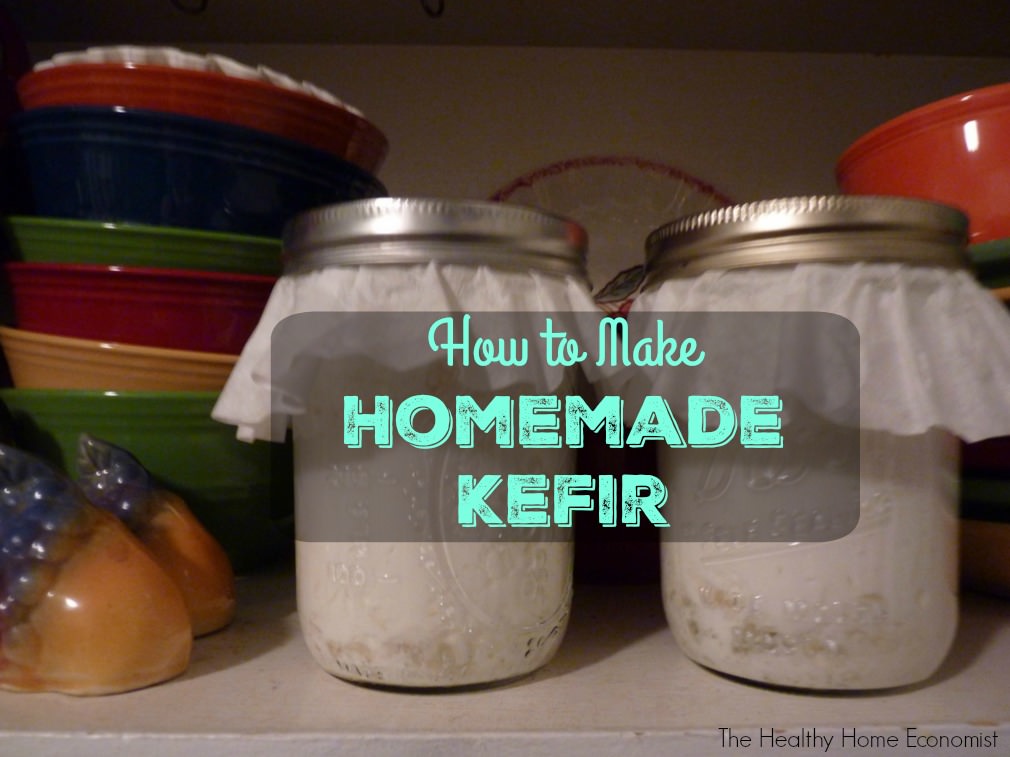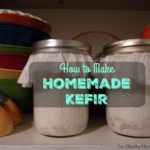Table of Contents[Hide][Show]
How to make homemade kefir the traditional way by fermenting on the counter for 24 hours with farm fresh milk.

I prefer homemade kefir to yogurt because yogurt only has 2-5 strains of beneficial bacteria None of these aggressively attack and destroy pathogens in the gut like the probiotics in kefir do.
By the way, kefir is pronounced ku-feer (not kee-fer or ke-fer).
Kefir made at home has dozens of beneficial bacterial strains as well as several beneficial yeasts. Kefir compared to yogurt is no competition. Kefir is much more beneficial for gut healing.
The one catch is that you need to learn how to make kefir yourself!
Commercial kefir brands typically have far less microbial strains and are not fermented long enough to have the same benefits.
Homemade Kefir Benefits
In a gut that is dominated by pathogens and candida overgrowth (as in someone who has taken many rounds of antibiotics and other prescription drugs over the years and/or eats primarily processed foods), yogurt tends to have only a temporary beneficial impact.
As mentioned earlier, homemade kefir has about 30 beneficial strains of bacteria and yeasts that do aggressively recolonize the gut by destroying pathogens.
As a result, kefir has the potential to permanently alter the gut environment for the better whereas yogurt does not.
The best way to make homemade kefir is to obtain live kefir grains from a friend. They grow slowly over time and extras can be given away (or even eaten as a live probiotic).
Avoid using powdered starter for kefir. It has little to no therapeutic value.
If you cannot find any live grains in your community, you can mail order them.
Other Types of Kefir Made at Home
If learning how to make other types of kefir interests you, check out this video on how to make water kefir.
This video plus recipe on how to make coconut milk kefir is helpful if you wish to make a dairy-free version of the milk-based kefir below.

Homemade Kefir Recipe
Easy recipe for homemade kefir fermented on the counter for 24 hours to maximize beneficial microbial strains for gut healing.
Ingredients
- 1 quart raw milk preferably grass-fed
- 1 wide-mouthed mason jar
- live kefir grains
Instructions
-
Pour the raw milk into a clean glass mason jar leaving about 1 inch at the top. You can use cold milk right out of the refrigerator if this is more convenient. Gently stir in live kefir grains. Roughly one-quarter cup of grains is sufficient to ferment the entire quart.
-
Screw on the lid and leave on the counter at room temperature for 24 hours. Over this time, you will see the milk slightly separate and thicken.
-
The kefir should be ready after 24 hours of fermentation time. If powder culture was used, you can use the kefir as is. If live kefir grains were used, gently strain them out to use again with the next batch of raw kefir.
Recipe Video
Recipe Notes
You do not need to rinse live kefir grains before using again. Rinsing them slightly weakens them in my experience.
Homemade kefir will last many weeks in the refrigerator, but its flavor will get stronger over time.








Hi, Sarah! We do use cod liver oil, but my youngest 3 boys have strep, by all symptoms. I think we picked it up on a recent trip. I really don’t want to do antibiotics or make a trip to the doctor. What are good alternatives, in your experience/opinion? I did buy some colloidal silver to try, but understand what you say about it killing good bacteria as well. Any ideas?
Hi Sarah.
I have contacted you a couple of times before and now have another question for you. I have been making milk kefir for maybe a year and a half and my trips to the farm are every couple of weeks. I usually get enough milk for those two weeks to make my kefir with. I do notice that when I make kefir with the older milk, it is naturally more sour and thin – to be expected. I have read that people use colloidal silver to help keep milk fresh, and I was wondering if using the silver (which is just a small amount in the milk) and then using the milk to make kefir would actually work and not kill the grains. Do you know anything about this? Thanks for your help.
Lori
Hi Lori, colloidal silver is antibacterial and will kill probiotics. This is why I rarely if ever use it as it will kill bacteria for an infection but also kill off good bacteria in your gut as well. Most people do not realize this. This would be a great blog post, actually!
Hi Jessica, I have never worked with dehydrated grains before so really do not have any tips to offer here. I would contact the company where you ordered the kefir grains and inquire regarding the situation.
Sarah,
I’m interested in purchasing kefir grains but Cultures for Health only sells the powder kefir culture or the dehydrated kefir grains. Do you have any other suggestions?
Also, love your blog!! I’m getting so much good information and help in my new journey to traditional eating. Thank you for all you do to help others!
Rachel
Sarah,
I ordered the milk kefir grains and have been soaking them in a cup of milk like the directions called for. It says to strain the grains out after 24 hours and add new milk. The question I have is that I can't seem to find the grains and the whole thing is very thick with jelly-like globules. There is no cauliflower like grains. I'm wondering if the milk is clabbering on the countertop? Should I be able to tell the what the grains are? I forgot about not using metal and the first day I strained it in a fine strainer, do you think the grains may have been harmed?
Jessica
Hi Jessica, I’m new to this and I’m having the exact same experience you described. (metal by accident…looks like it is clabbering.) I was just wondering what finally happened with yours? Did you have to start over??
April
I have a question about straining the grains out of the kefir. I don't think you showed that in the video. I know I can't use my little metal strainer. How do you suggest separating the grains back out when the kefir is finished? A fine cheese cloth?
B
Hi Erika, OMG! They will grow inside you :O LOL, Seriously, You can eat the Kefir Grains, they are very good for you! The reason people save them is to make another batch, if you get to the stage when you would have more then what you need, just eat them! Don't throw them out! :O They are very yummy! 😀
Hi ! I was wondering.. when you make kefir.. (sometimes I notice the grains are different size masses) I take out as much as I can to save them in a different jar.. but is it okay to drink the kefir.. if there are a few grains left in it that you couldn't scoop out after fermentation?
~Erika
Absolutely! So healthy!
LoL Everytime I hear you English speaking people pronounce "Kefir" my friend and I laugh like crazy LoL Why don't you go and meet a Russian person or anyone from Eastern Europe and ask them to pronounce it for you 😉 You Sarah actually pronounce it more closer how it supposed to sound than what I have heard from some other people, like (keefar) lol only that when you say (fir) it is not (fear) sound like you make it, its more of strong and short Fir!. Hard to explain here. 🙂 I guess you don't even have a sound like that in English language. You would really have to listen to us say it, even someone from Germany would be able to pronounce it for you properly. Its not really hard. I might make a video on YouTube one day. All the best, and don't forget to drink your KeFir!!!!
Hi! We also make Kefir and have no problems with fermenting ultra-pasterized organic milk! Raw is sooooooooo much more expensive than pasterized and so is kind of a luxery in our home 🙂
Hi Cindy, you are most certainly right. Metal should never touch your kefir grains. However, using a metal lid on your mason jar is fine as the grains don't ever touch it. I've used mason jars for years and don't remember a single time my grains ever came in contact with the lid. You just have to be extra careful. If you have another glass container with a plastic lid, that is probably a better choice.